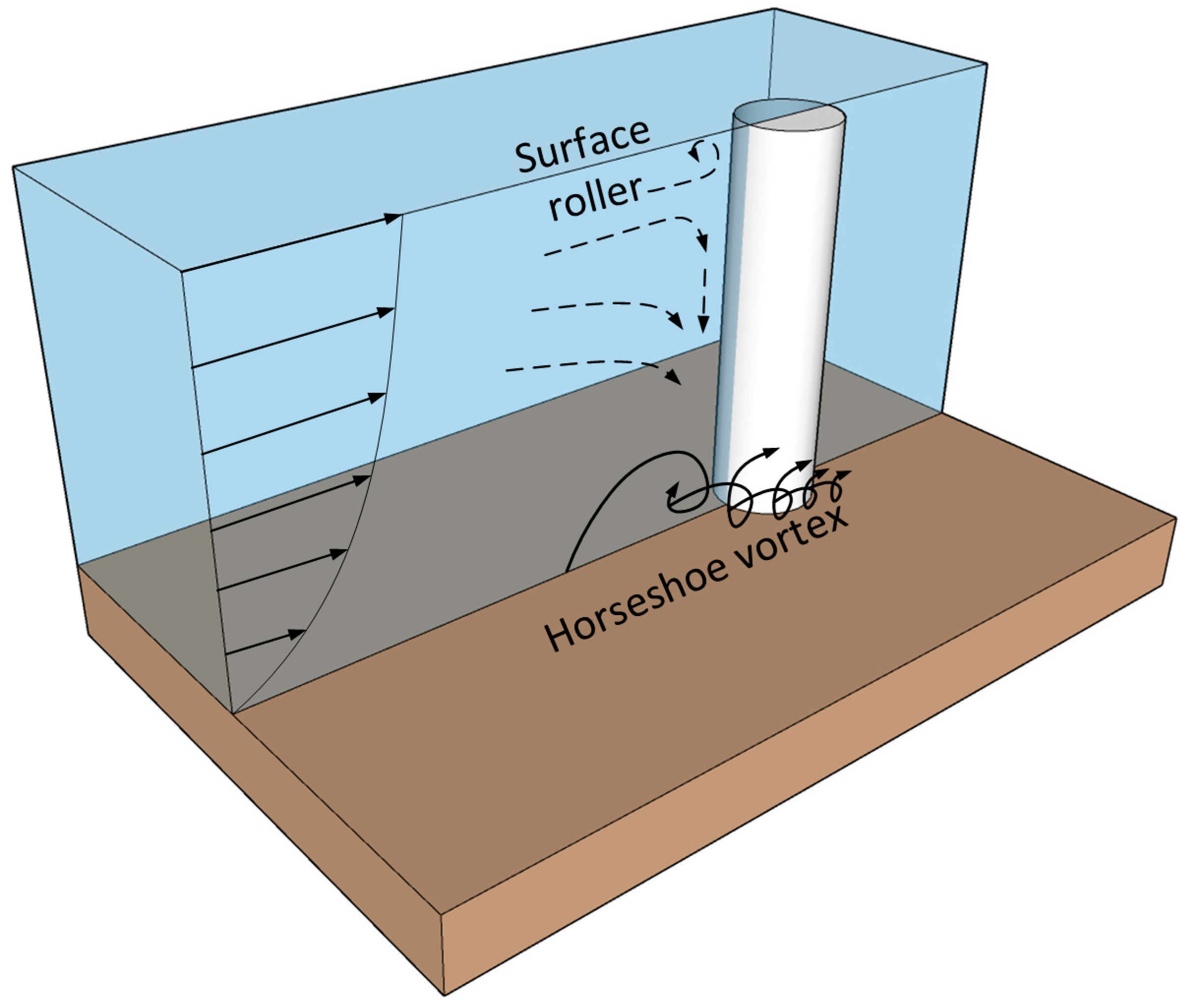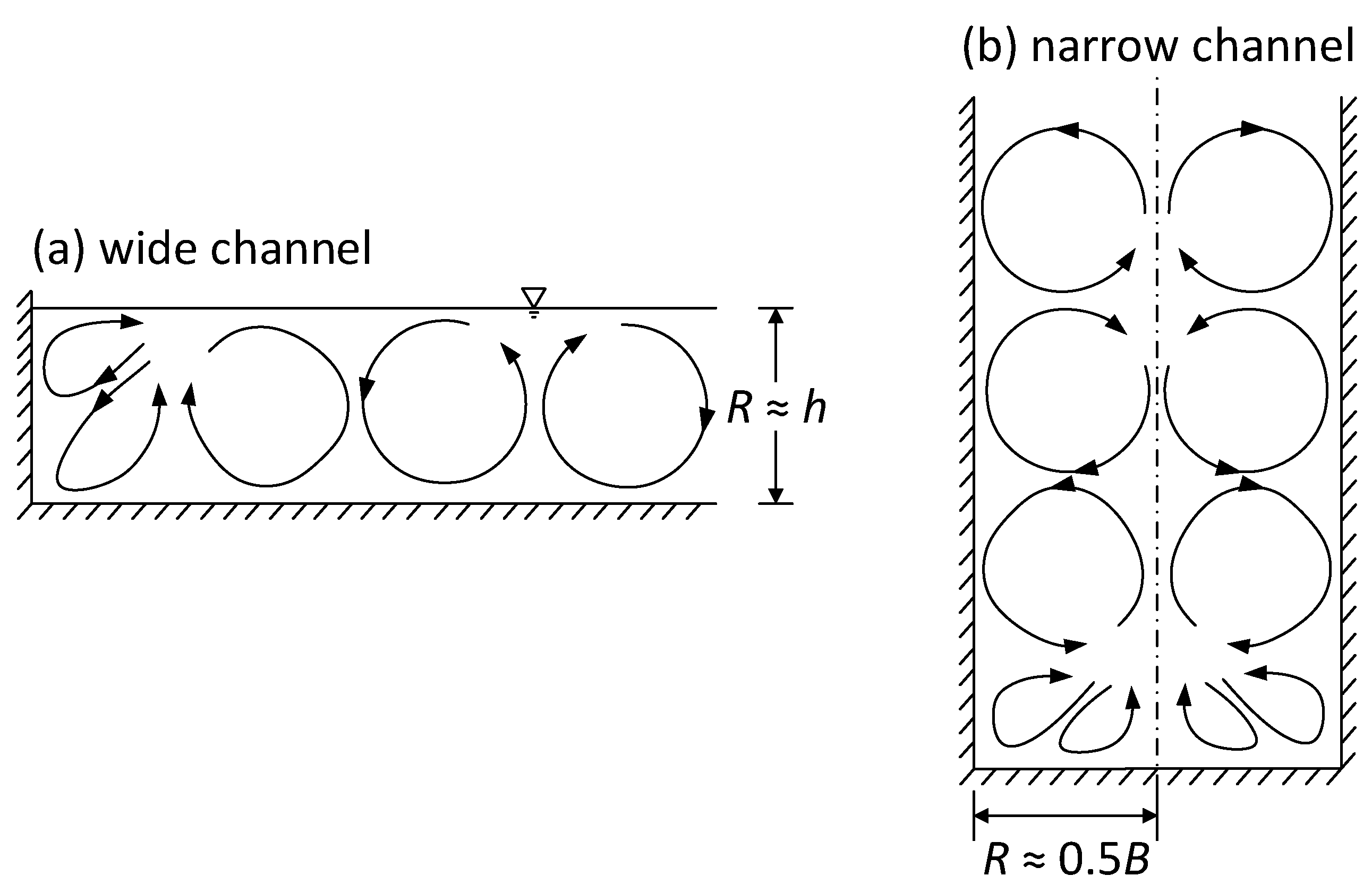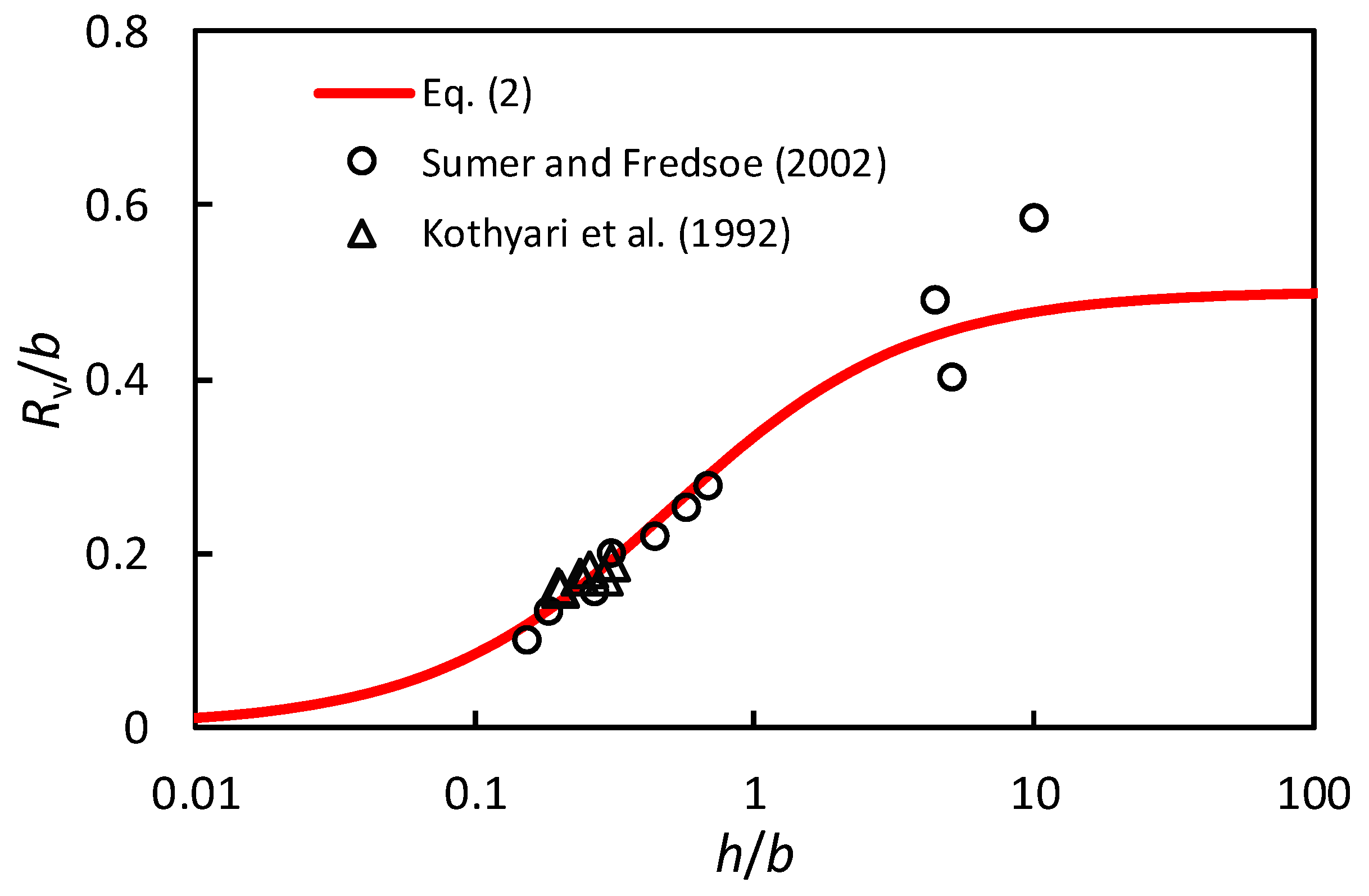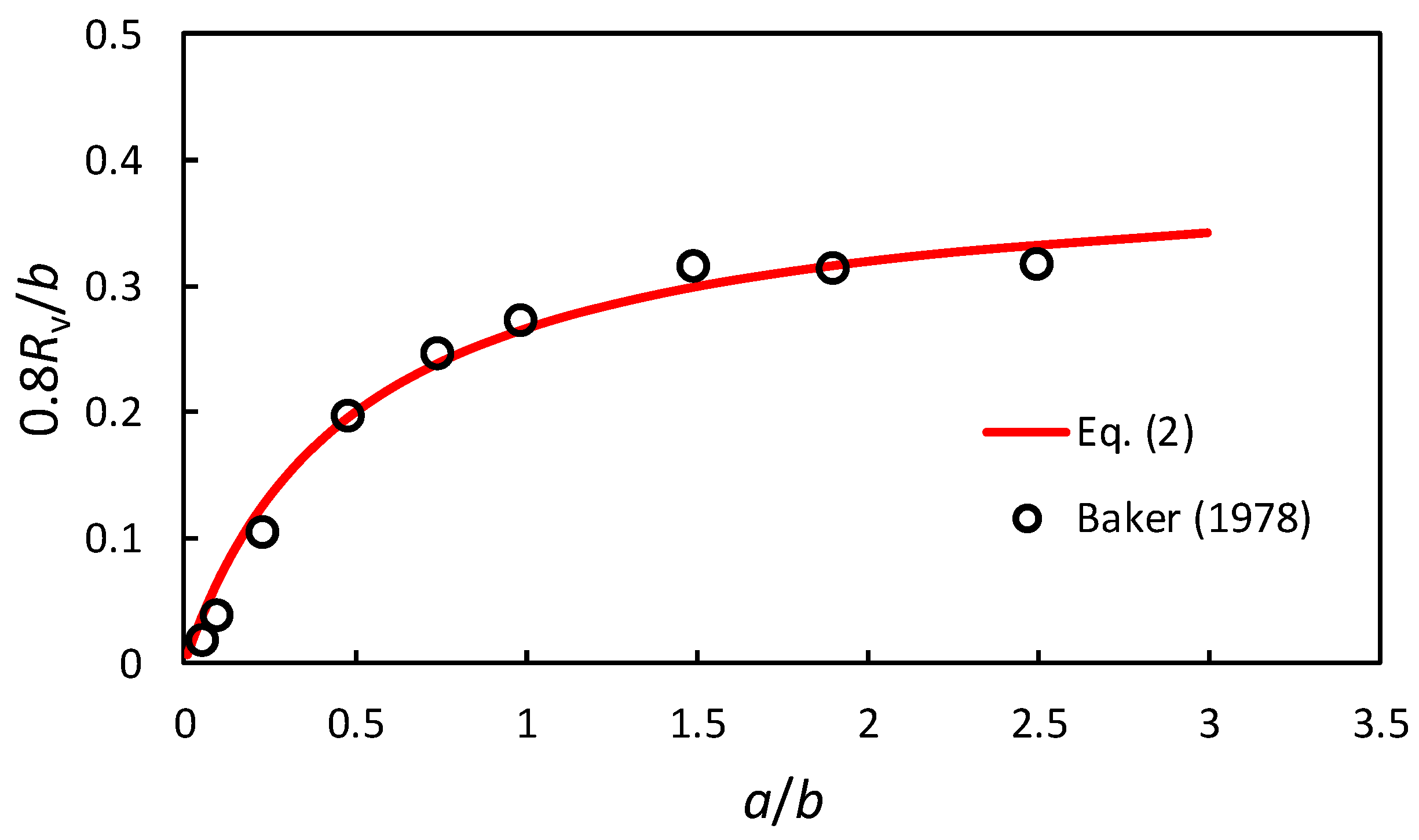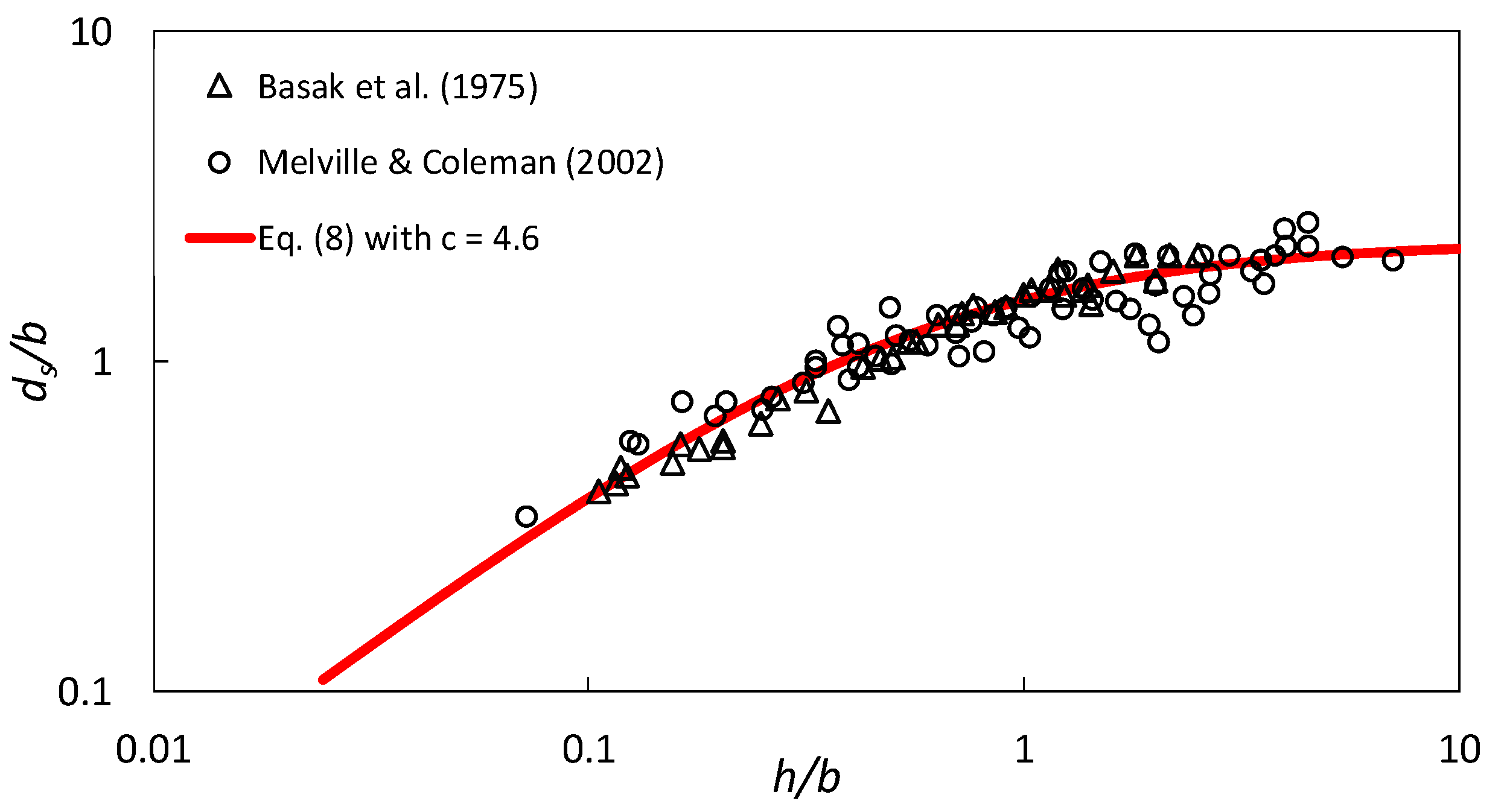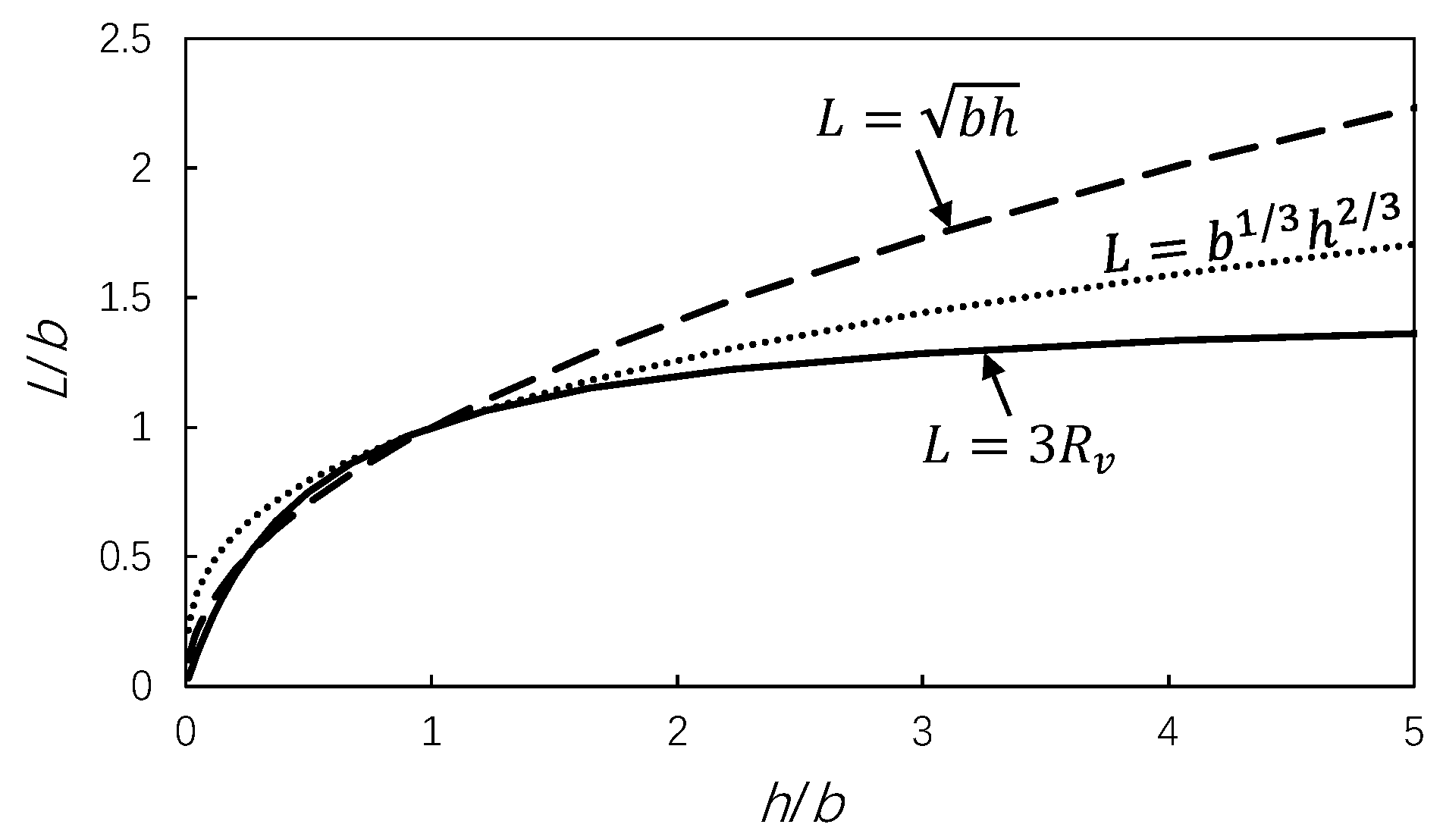1. Introduction
Scour has been long recognized as the most common cause of bridge failures [
1], among which some notorious failure cases were recently documented by Hong et al. [
2,
3]. The local scour at a bridge pier is affected by several factors, including approach flow depth and velocity, sediment grain size and gradation, and pier width, shape and alignment. Among these factors, flow depth effect has been investigated extensively by Raudkivi and Ettema [
4], Chiew [
5], Melville and Coleman [
6], Oliveto and Hager [
7], Ettema, et al. [
8], and Guo [
9]. These studies show that maximum scour depth varies at different scales under different flow depth conditions. For deep flows, if the ratio of flow depth
h to pier width
b is greater than four, i.e.,
h/b > 4, the flow depth effect is negligible, and the scour depth increases as the pier width increases. In comparison, for shallow flows (e.g.,
h/b < 0.2), the scour depth is proportional to the flow depth, but independent of the pier width. For intermediate flows, the scour depth varies with both flow depth and pier width. Such variations could be associated with the interaction between the near-bed horseshoe vortex and the surface roller [
4].
Given the complex mechanism of the three-dimensional flow around a pier, it is almost impossible to conduct an analytical evaluation of the flow depth effect on the maximum scour depth [
4]. Recently, Manes and Brocchini [
10] proposed a theoretical framework, including all the non-dimensional parameters controlling the scouring process. In their study, the flow depth effect was implicitly incorporated in the drag coefficient of the pier and the shallow flow effect was intentionally discarded. On empirical grounds, many experimental and numerical observations have been performed for the last few decades, e.g., [
6,
11,
12,
13,
14,
15,
16,
17,
18], which have collectively shown that the large-scale flow structure (i.e., the horseshoe vortex system) forming at a bridge pier acts as the principal agent that causes the local scour. The large-scale vortex appears to be much stronger than the eddies generated by the sweep and ejection events, as observed in turbulent flows over a smooth or rough channel bed [
19]. For deep flows, the strength of a horseshoe vortex is only related to the pier width, and thus the scour depth is not affected by flow depth; while, for shallow flows, the development of the horseshoe vortex is limited by the flow depth, which affects the scour depth. It should be noted that the focus of this study is limited to the case of uniform current flow where the downward flow-induced horseshoe vortex is the leading cause for the scouring action. In comparison, wave-induced scouring is mainly dominated by the lee-wake flow [
20,
21], which is beyond the scope of this paper.
By noting the significant role of the horseshoe vortex in the local scour, the flow depth effect could be evaluated alternatively by investigating how the flow depth influences the size of the horseshoe vortex even at the beginning of scour. Such an effort is made in the present study. In the following, the characteristics of the horseshoe vortex are briefly described. Then, the concept of hydraulic radius is applied to quantify the dimension of the horseshoe vortex. Finally, the result is compared with experimental data published in the literature. To facilitate the relevant analysis, it is assumed that: (1) the viscous effect is negligible; (2) the sediment is uniform, with the grain size much smaller than the pier width; (3) the approach flow is close to the threshold condition for incipient sediment motion; and (4) the pier is circular.
2. Characteristics of Horseshoe Vortex
The presence of a bridge pier obstructs the approach flow and causes the boundary layer separation, which yields two rollers around the pier, a surface roller, like bow wave to a boat, and a base roller or horseshoe vortex system [
4]. The two rollers rotate in opposite directions, which are connected by the downflow in front of the pier, as sketched in
Figure 1.
The formation of the horseshoe vortex can be linked to both streamwise and transverse pressure gradient of the flow around a pier [
12]. The streamwise adverse pressure gradient causes the approach boundary layer to separate and then give rise to multiple horseshoe vortices or a horseshoe vortex system, while the transverse pressure gradient directs the flow to move around the pier, stretching the horseshoe vortices towards downstream. The number of vortices may increase with increasing Reynolds number, but the dimension of the vortex system is independent of Reynolds number and primarily determined by the pier diameter [
22].
Baker [
14] stated that the horseshoe vortex system functions as a sink, which drains away the fluid that flows into the vortex upstream of the pier. For a bridge pier with a given width, the flow depth affects how much flow goes through the horseshoe vortex system. Typically, the horseshoe vortex system causes significant increases in the bed shear stress and turbulence intensity. For example, Baker [
14] reported that within the horseshoe vortex system, the turbulence intensity (the ratio of the streamwise velocity fluctuation to the local time-mean velocity) was approximately three times higher than that for the undisturbed boundary layer. Sumer and Fredsøe [
23] observed that the maximum bed shear stress appeared at the midway from the front to the side edge of a pier, which was at least five times higher than that for the undisturbed approach flow. Likewise, Li et al. [
24] experimentally measured the flow characteristics in front of a cylinder, showing that both the mean and fluctuations of bed shear stress are significantly augmented due to the formation of turbulent horseshoe vortex. The large amplification of the turbulence intensity and bed shear stress, which greatly enhances the flow capability to entrain and transport sediment particles [
19], substantiates the central role of the horseshoe vortex system in initiating the local scour and thus generates the potential maximum scour depth. Therefore, it is rational to assume that scour depth is closely related to the size of the horseshoe vortex before scour. In the following, the size of the horseshoe vortex is quantified by applying the concept of hydraulic radius.
3. Pier Hydraulic Radius
In open channel flows, the hydraulic radius is traditionally defined as the ratio of the area of a cross-section to its wetted perimeter. It can be used for computing the average boundary shear stress at a cross-section under uniform flow conditions. On the other hand, the hydraulic radius also provides a reasonable measurement of the dimension of the large-scale flow structures. As sketched in
Figure 2, it can be approximated as the flow depth
for a wide channel and one half of the channel width
for a narrow channel [
25]. Mathematically, the hydraulic radius
is expressed as:
Similar to the large-scale flow structure identified in the cross-section of an open channel flow, the horseshoe vortex system is also confined by the two parameters, i.e., flow depth and pier width . This suggests that the concept of hydraulic radius is applicable for quantifying the size of the horseshoe vortex, as detailed subsequently.
The horseshoe vortex is highly three-dimensional. However, only the leading part of the vortex, as observed in front of a pier before the scour, is considered in this study. This is because it predefines the maximum scour depth in spite of the fact that its size and structure evolve as the local scour develops. In the symmetry plane of the pier, the streamwise or vertical dimension of the horseshoe vortex could be quantified using the flow depth. In the vertical direction, the size of the horseshoe vortex may be limited up to the flow depth, if the flow is shallow. The streamwise dimension of the vortex, if assumed to be comparable to its vertical dimension [
26], is also in the order of the flow depth. Laterally, the vortex size would be in the order of the pier width, provided that the pier is not wide in comparison with the flow depth. Therefore, in the initial stage of the local scour at a pier, the horseshoe vortex is confined by the two length scales, flow depth
and pier width
, which, respectively, characterize the scale of energy-containing eddies in channel flow and pier-associated flow [
10]. This is similar to the large-scale flow structure confined by the cross-section of an open channel flow. Consequently, as a first approximation, it is proposed here to apply the concept of hydraulic radius in the determination of the horseshoe vortex size.
Similar to Equation (1), the dimension of the horseshoe vortex
can be expressed as:
where
may be referred to as the pier hydraulic radius. It is noted that
, as a combination of
and
, provides a length scale that describes the typical size of the horseshoe vortex. In the following, Equation (2) is compared with laboratory measurements available in the literature.
Experimentally, the dimension of the horseshoe vortex has been measured using different approaches in previous studies. Baker [
14] and Sumer and Fredsøe [
23] measured the distance from the separation point of the boundary layer to the pier center. Through flow visualization in a wind tunnel, Baker [
14] showed that the separation distance is proportional to the pier height for submerged cylinders, and proportional to the pier width for long cylinders. As discussed subsequently, the effect of the cylinder height on the formation of the horseshoe vortex in the wind tunnel is comparable to that of the flow depth in an open channel. Alternatively, Kothyari et al. [
26] quantified the vortex size as the vertical distance from the channel bed to the point where the fluid flows downward along the front surface of the pier.
Figure 3 shows the comparison of Equation (2) with the data from Sumer and Fredsøe [
23] and Kothyari et al. [
26]. Since Kothyari et al. [
26] presented that narrow channels induced significant variations in the vortex size, only the dataset with the ratio of the channel to pier width greater than 10 is used here for comparison. From
Figure 3, it can be seen that Equation (2) agrees well with the two sets of data, without involving any adjustable coefficient.
Additionally, Equation (2) is also compared in
Figure 4 with another set of data reported by Baker [
14], who measured the separation distance of the horseshoe vortex in front of a cylinder with different heights. For this comparison, the flow depth
in Equation (2) is simply replaced with the cylinder height. As shown in
Figure 4, all the measured separation distances are approximately equal to 80% of
calculated using Equation (2). It should be noted that Baker [
14] measured two sets of separation distances, and indicated that due to the experiment setup, the set of measurements for the separation point closer to the leading edge of the cylinder was more accurate, which are used here for the comparison.
Both
Figure 3 and
Figure 4 show that the length scale,
, defined in Equation (2), can be used to quantify the size of the horseshoe vortex. If assuming that the scour depth is comparable to the dimension of the horseshoe vortex, then
, as a length scale, can be further used to describe the combined effect of flow depth and pier width on the scour depth. This will help simplify the dimensional analysis, as demonstrated in the next section.
4. Dimensional Analysis
For a bridge pier simulated using a circular cylinder mounted vertically at a sediment bed in a wide channel, the maximum scour depth
generally depends on the following nine parameters:
where
is the pier width or cylinder diameter,
is the approach flow depth,
is the approach flow velocity,
is the median sediment grain diameter,
is the geometrical standard deviation,
is the fluid density,
is the grain density,
is the gravitational acceleration, and
is the kinematic viscosity of fluid. If assuming that (1) both the viscous effect and sediment non-uniformity are negligible, (2) the reduced gravitational effect for submerged sediment grains is described using
, and (3) the scour depth scales with the hydraulic pier radius
, a combination of
and
, Equation (3) can be reduced to
Choosing
and
as repeating variables, Equation (4) can be rewritten in the dimensionless form as
where
is the densimetric Froude number,
When ignoring the viscous effect, the settling velocity
of a sediment particle is proportional to
. Therefore,
measures the relative intensity of the approach flow in comparison to the gravitational effect of sediment particles. The ratio of
serves as a description of the relative roughness height of the sediment bed. On a side note, a notable contribution to improve the underlying physics of local scouring process is due to the work of Manes and Brocchini [
10], who proposed a theoretical expression of the equilibrium scour depth as a function of the kinetic head of the undisturbed approach flow, specific gravity of the sediment, drag coefficient, and relative coarseness. Note that Manes and Brocchini’s [
10] deviation was based on the perception that the equilibrium scour depth scales with the size of fully developed vortex that buried in the equilibrium scour hole, whereas the concept of
developed in this study characterizes the initial size of the vortex generated at the onset of the scouring.
To single out the flow depth effect, some specific cases need to be considered so that both
and
in Equation (5) can be ignored. First, the effect of
can be discounted when
approaches a constant, for example, when the approach flow is close to the threshold condition for incipient sediment motion. This is because when the viscous effect is negligible, the critical flow velocity
for incipient sediment motion is proportional to the settling velocity
and thus
, i.e.,
[
27,
28]. Furthermore, it is noted that the effect of
becomes important only for relatively coarse sediment grains. For example, Chiew [
5] showed that for the local scour in deep flows,
appears to be a minor factor for
. With the above considerations, the flow depth effect would be better examined for the pier scour at a sediment bed composing relatively fine sediment grains (e.g.,
for deep flows) under the threshold condition for sediment motion. Such restrictions will be considered for the subsequent data comparison.
Without considering
and
, Equation (5) is finally simplified to
Equation (7) implies that the scour depth is simply proportional to the pier hydraulic radius. With Equation (2), Equation (7) can be rewritten as
where
is a constant. Equation (7) or Equation (8) provide a simple theoretical description of the flow depth effect on the pier scour.
